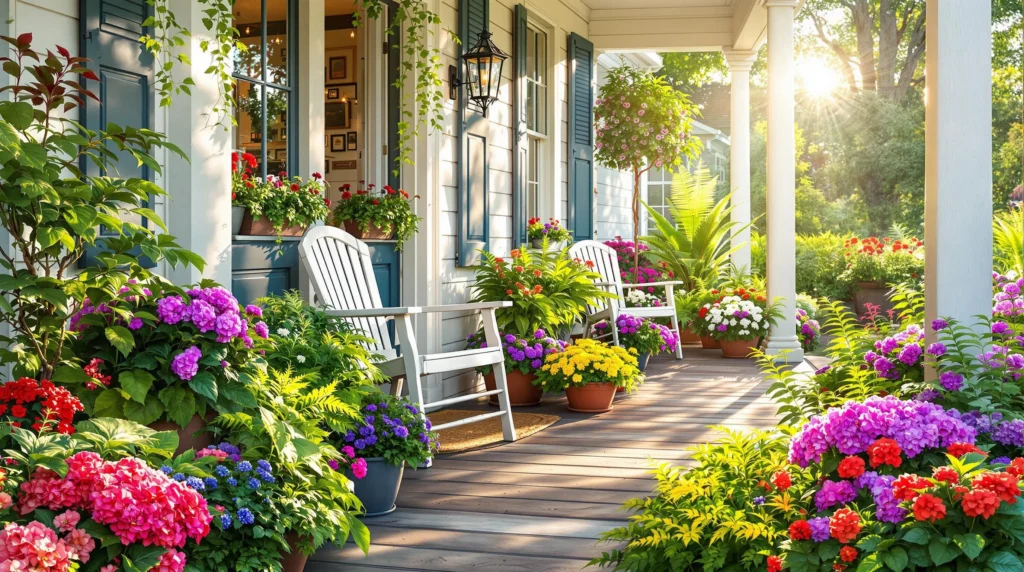10 Best Front Porch Plants to Create a Welcoming Entryway
1. Hydrangeas
Hydrangeas create an instant elegant statement with their large, showy blooms. These versatile shrubs thrive in containers and adapt to various light conditions, making them perfect for porches that receive morning sun and afternoon shade. Available in blue, pink, white, or purple depending on your soil pH, hydrangeas offer dramatic visual impact from spring through fall.
2. Boxwood
Boxwoods provide year-round structure and evergreen color to your porch design. These classic shrubs can be shaped into formal topiaries or left natural for a more relaxed look. Place them symmetrically on either side of your door in decorative containers for a timeless, polished entrance that requires minimal maintenance.
3. Ferns
Boston ferns and maidenhair ferns add lush, cascading greenery that softens hard architectural lines. These shade-loving plants thrive in hanging baskets or elevated planters, creating dimension and movement. Their air-purifying qualities and humidity-loving nature make them particularly well-suited for covered porches in moderate to warm climates.
4. Petunias
Petunias deliver non-stop color throughout the growing season with minimal care. Available in virtually every color of the rainbow, these flowering annuals spill beautifully over container edges and provide instant curb appeal. Their trumpet-shaped blooms attract butterflies and hummingbirds, adding life and movement to your entrance.
5. Lavender
Lavender brings both visual appeal and aromatherapy benefits to your front porch. The silvery-green foliage and purple flower spikes create a Mediterranean vibe while releasing a calming scent when visitors brush past. Plant lavender in terracotta pots with well-draining soil for a drought-tolerant, bee-friendly addition to sunny porches.
6. Snake Plant
Snake plants offer architectural interest with their striking vertical leaves and exceptional durability. These practically indestructible plants thrive on neglect and adapt to various light conditions, making them perfect for busy homeowners or those new to gardening. Their air-purifying abilities and modern aesthetic work particularly well in contemporary porch designs.
7. Geraniums
Geraniums provide reliable, long-lasting color that can withstand hot, sunny conditions. Their rounded flower clusters in red, pink, white, or salmon create a cheerful, cottage-garden feel. Plant them in window boxes or traditional containers for a classic look that blooms from spring until frost with just minimal deadheading.
8. Hostas
Hostas create dramatic foliage displays in shaded porch areas where few flowering plants thrive. Available in various sizes and leaf patterns—from solid blue-green to variegated cream and green—these perennials provide season-long interest with minimal maintenance. Their architectural leaves create beautiful textural contrast when paired with more delicate plants.
9. Coleus
Coleus plants offer kaleidoscopic foliage in shades of burgundy, chartreuse, orange, and purple without needing flowers to make an impact. These fast-growing annuals thrive in partial shade and create instant drama in containers. Mix several varieties together for a vibrant, low-maintenance display that lasts from spring through fall.
10. Dwarf Citrus Trees
Dwarf citrus trees bring unexpected charm to front porches with their glossy leaves, fragrant flowers, and colorful fruit. Varieties like Meyer lemon, kumquat, or calamondin orange remain compact in containers while providing year-round interest. Beyond their ornamental value, they offer the bonus of fresh fruit, making them both beautiful and functional porch plants.
Choosing the Right Front Porch Plants for Your Climate Zone
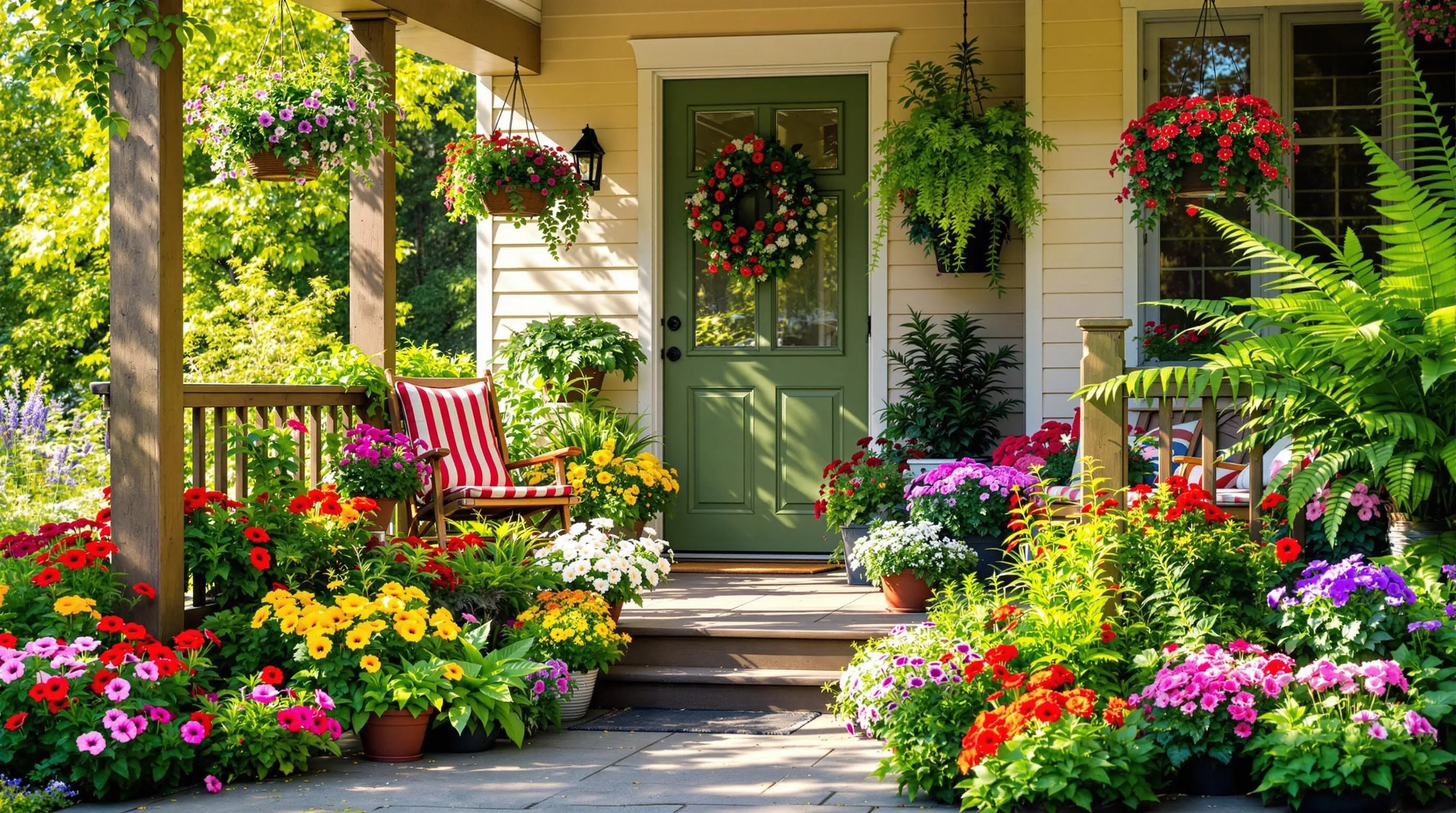
Selecting plants that thrive in your exact climate zone is crucial for creating a sustainable and vibrant front porch display. Plants that aren’t suited to your region’s temperature range and weather patterns will struggle to survive, wasting your time and money. Here’s how to choose the perfect front porch plants for your location.
Understanding Your USDA Hardiness Zone
The USDA Hardiness Zone map divides North America into 13 zones based on average annual minimum winter temperatures. Before purchasing any plants, identify your exact zone by checking the USDA’s online map or consulting with your local garden center. Zone 3 regions (parts of Alaska, Minnesota) require cold-hardy options like ornamental grasses and evergreen shrubs. Middle zones 5-7 (Chicago, New York) support versatile choices including hydrangeas and boxwoods. Warmer zones 8-10 (Southern California, Florida) can sustain tropical varieties like hibiscus and bougainvillea. Always check plant labels for zone compatibility—choosing plants rated for your zone or even one zone colder ensures they’ll withstand your local winter conditions.
Considering Sun Exposure on Your Porch
The amount of sunlight your porch receives daily dramatically affects which plants will thrive there. Monitor your porch throughout the day to determine its sun exposure pattern. Full sun locations (6+ hours direct sunlight) are perfect for petunias, geraniums, and lavender. Partial sun areas (3-6 hours) support coleus, begonias, and impatiens. Shady porches (less than 3 hours) call for hostas, ferns, and caladiums. North-facing porches typically receive the least sun, while south-facing ones get the most intense exposure. East-facing porches enjoy gentle morning sun, making them ideal for plants that prefer moderate light. Remember that seasonal changes affect sun patterns—a spot that’s sunny in summer might be shadier in fall, requiring adaptable plant selections.
Low-Maintenance Front Porch Plants for Busy Homeowners
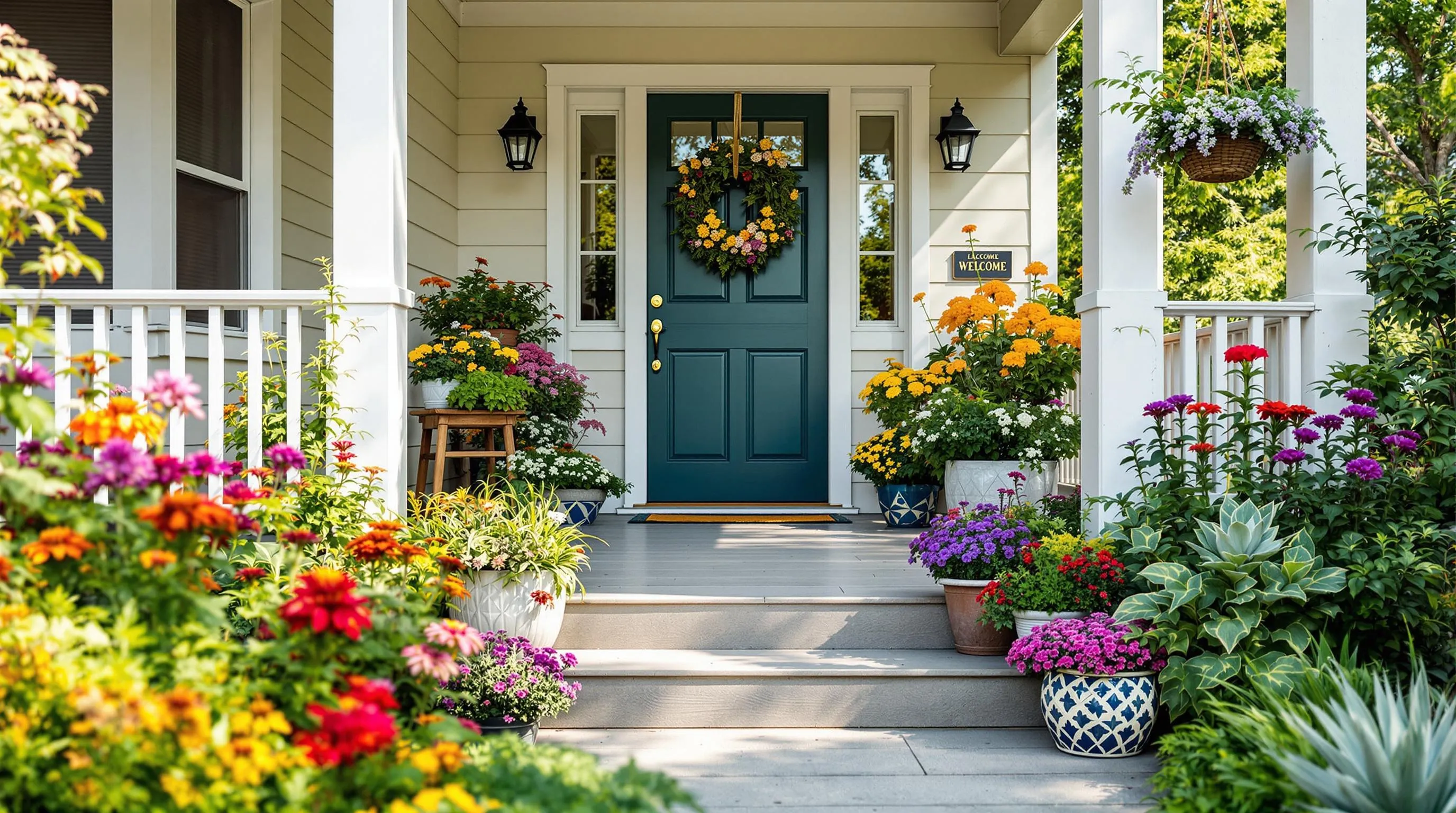
Looking for plants that don’t require constant attention? These low-maintenance options will keep your front porch looking great without demanding hours of your time each week.
Drought-Tolerant Options That Thrive With Minimal Care
Drought-tolerant plants are perfect for busy homeowners who can’t water frequently. Succulents like Aloe and Echeveria require watering just once every 2-3 weeks and thrive in decorative containers. Sedums create cascading textures that look stunning in hanging baskets while needing minimal moisture. Yucca plants add dramatic architectural interest with their sword-like leaves and can survive weeks without water. Agave varieties offer striking geometric forms and store water in their thick leaves, making them virtually maintenance-free. Pair these with ornamental grasses like Blue Fescue or Fountain Grass that need trimming only once annually while providing movement and texture to your porch display.
Perennial Front Porch Plants That Return Year After Year
Perennials deliver exceptional value by coming back each season with minimal effort. Coneflowers (Echinacea) produce colorful daisy-like blooms that return reliably for 3-5 years and attract butterflies to your entrance. Black-eyed Susans offer bright yellow flowers from midsummer through fall with virtually no care beyond occasional deadheading. Coral Bells (Heuchera) provide year-round interest with their colorful foliage in shades of purple, amber, and lime green. Daylilies are nearly indestructible, blooming for weeks each summer in containers without requiring division for 4-6 years. Russian Sage delivers airy purple flowers and silvery foliage that stands up to heat, drought, and neglect while deterring deer and rabbits from your porch plantings.
Seasonal Front Porch Plants to Rotate Throughout the Year
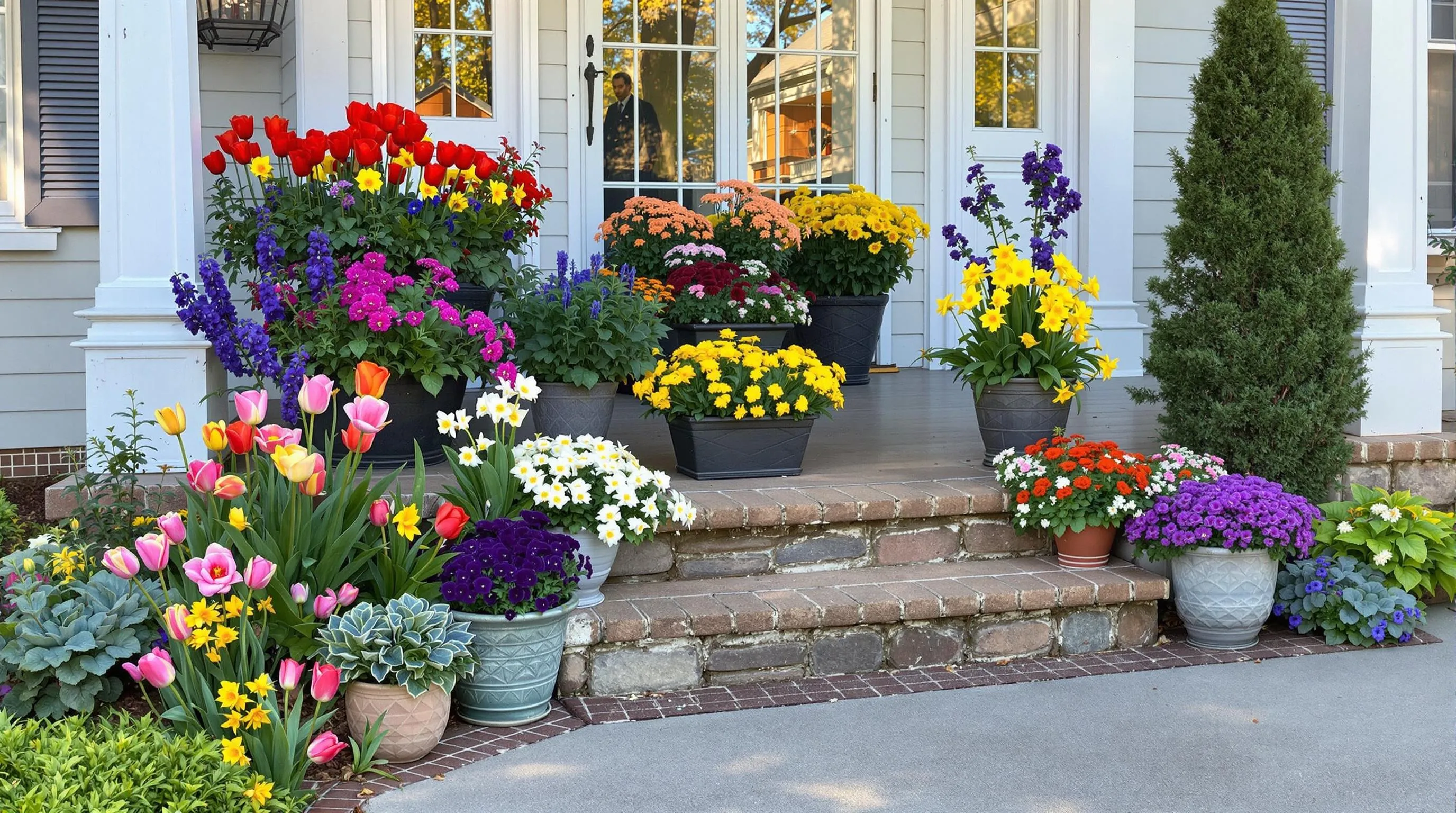
Keeping your front porch fresh and inviting throughout the year means rotating plants with the changing seasons. This approach ensures your home’s entrance always looks its best while showcasing seasonal beauty.
Spring Favorites for Fresh Color
Spring calls for plants that announce the end of winter with vibrant blooms and fresh foliage. Tulips and daffodils make perfect statement pieces with their bright colors and distinctive shapes. Place these bulb flowers in decorative pots for instant curb appeal. Pansies thrive in cool spring temperatures and offer faces of purple, yellow, and blue that withstand light frosts. Add azaleas for dramatic flowering shrubs that create height in your display, especially in partial shade locations. Don’t forget primroses, which provide charming clusters of yellow, pink, and purple blooms that brighten early spring days when many other plants haven’t yet awakened.
Summer Stunners That Beat the Heat
Summer demands plants that can withstand high temperatures while maintaining their beauty. Lantana offers clusters of multicolored flowers that attract butterflies and withstand drought conditions beautifully. Calibrachoa (million bells) cascades over pot edges with hundreds of miniature petunia-like blooms that don’t require deadheading. For dramatic height, canna lilies deliver tropical flair with their bold foliage and bright flowers on stems reaching 3-6 feet tall. Incorporate sweet potato vines as trailing accents that spill over containers with their chartreuse or purple heart-shaped leaves. Hibiscus plants, with their dinner-plate-sized blooms in tropical hues, create a vacation vibe that thrives in summer’s heat and humidity.
Fall and Winter Front Porch Plants for Year-Round Appeal
When temperatures drop, transition to cold-hardy options that offer texture and color. Ornamental kale and cabbage create stunning displays with their purple, pink, and white rosettes that actually intensify in color after frost. Chrysanthemums provide classic fall color in golds, burgundies, and russets that complement autumn decorations. For winter structure, dwarf evergreens like Alberta spruce or blue star juniper maintain interest through the coldest months. Holly plants with their glossy leaves and bright red berries offer traditional winter appeal and holiday spirit. Winter pansies surprise with their cold tolerance, often blooming through mild winters in zones 7-9, while ornamental grasses like miscanthus or pennisetum add movement and texture with their graceful seed heads persisting through winter snows.
Container-Friendly Front Porch Plants That Make a Statement
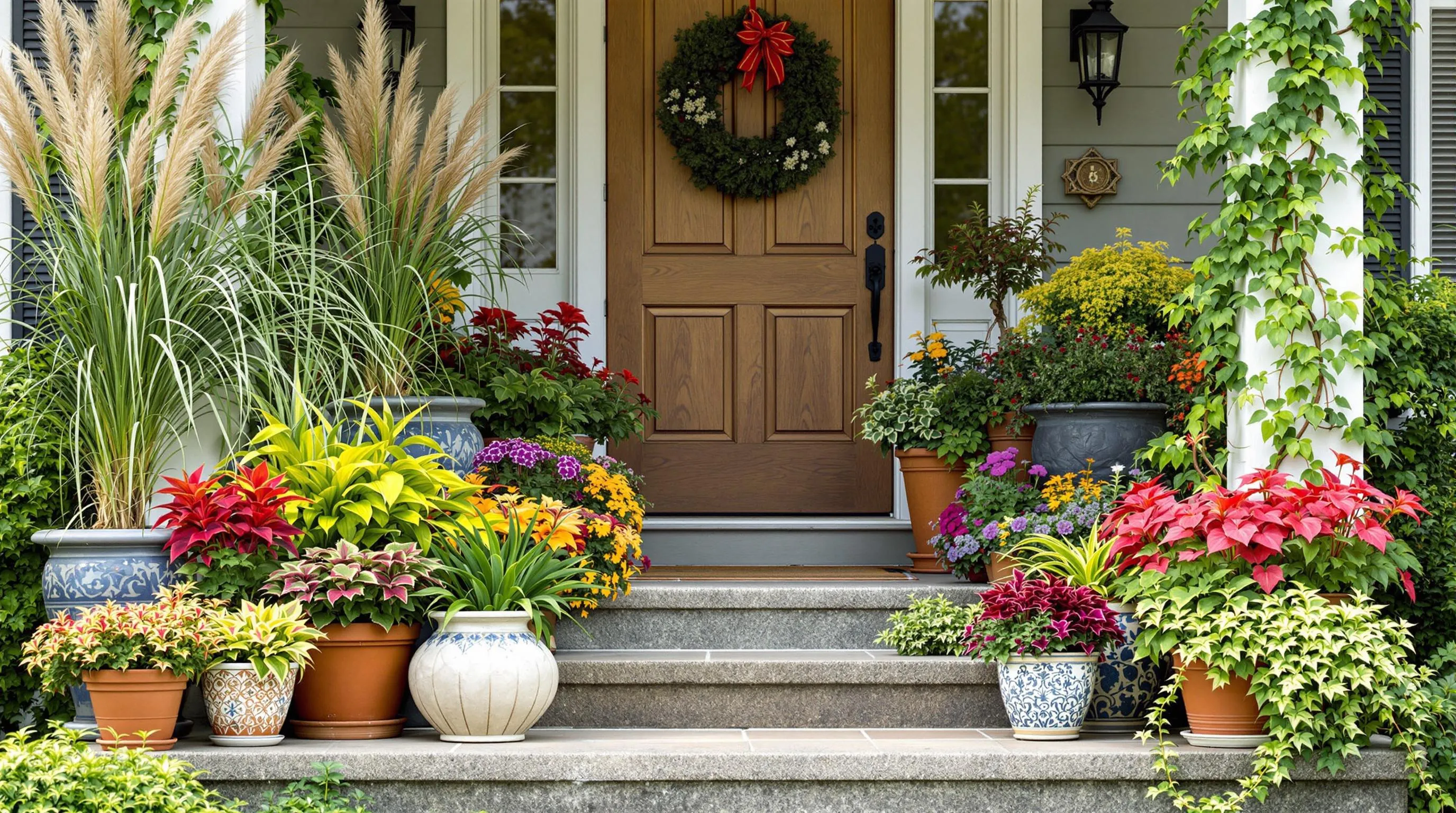
When it comes to front porch décor, container plants offer versatility and visual impact without requiring extensive garden space. The right potted plants can transform your entrance from ordinary to extraordinary, creating focal points that reflect your personal style while improving your home’s curb appeal.
Best Pots and Planters for Front Porch Plants
Selecting the right containers is just as important as choosing the plants themselves. Tall ceramic planters create vertical interest and work perfectly for statement plants like small trees or tall grasses. Weather-resistant fiberglass pots offer durability and come in various colors and styles to match your home’s exterior. For a classic look, terra cotta pots provide warmth and timeless appeal, though they require additional winter protection in colder climates. Window boxes mounted beneath porch railings maximize space while creating a cottage-garden feel. For a coordinated look, use containers in odd-numbered groupings (3 or 5) with varying heights but consistent materials or colors. Always ensure your planters have proper drainage holes to prevent root rot, and consider self-watering containers if you frequently forget to water your plants.
Creating Attractive Plant Combinations and Arrangements
The most eye-catching container gardens follow the “thriller, filler, spiller” principle. Start with a tall, architectural plant as your “thriller” – consider ornamental grasses like purple fountain grass or structural plants like cordyline. Add “filler” plants like coleus, caladium, or begonias to create fullness and add contrasting textures. Finish with “spiller” plants that cascade over the edges, such as sweet potato vine, creeping jenny, or trailing petunias. Create visual interest by combining plants with different foliage colors – pair chartreuse sweet potato vine with deep purple heuchera for dramatic contrast. Mix plants with similar water and light requirements to ensure all thrive in the same container. For year-round appeal, incorporate evergreens as anchors in your arrangements, then swap seasonal bloomers throughout the year. Position your most impressive container gardens near your front door where they’ll create maximum impact for both visitors and passersby.
Tall Front Porch Plants for Privacy and Screening
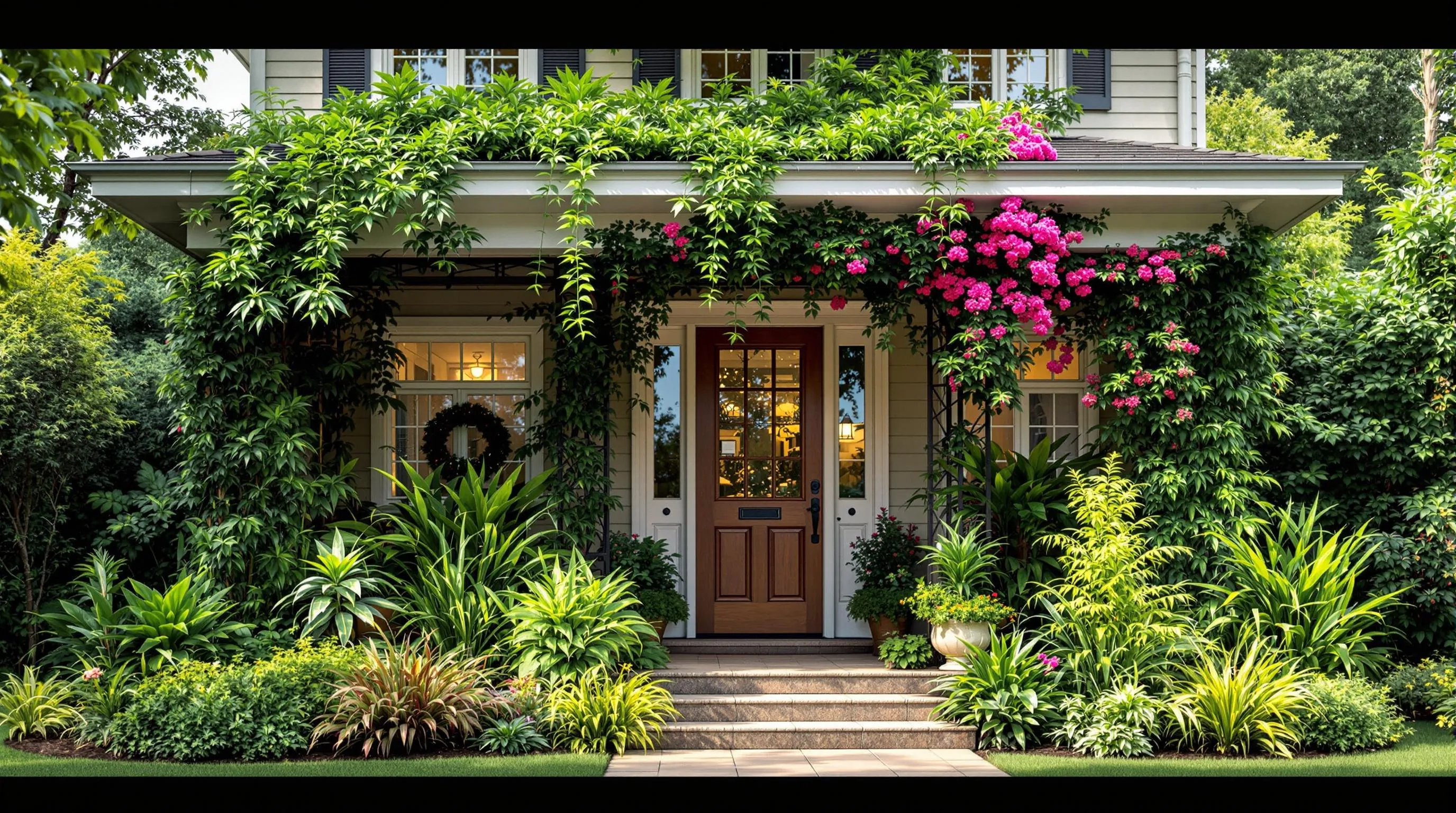
Transform your front porch into a private sanctuary with strategic plantings that create natural barriers while improving your home’s curb appeal. Tall plants not only provide much-needed privacy from neighbors and passersby but also add architectural interest and create a lush, inviting entrance.
Creating Natural Barriers With Strategic Placement
Position bamboo plants in large containers on either side of your porch steps to establish an elegant privacy screen that grows quickly and creates a dramatic entrance. Tall ornamental grasses like Miscanthus or Pennisetum reach 4-6 feet in height and offer year-round screening with their graceful, swaying plumes. For dense coverage, consider arborvitae or Italian cypress trees in sturdy planters—these evergreens maintain their privacy-providing foliage throughout all seasons while creating a formal, structured look. Flowering options like hollyhocks or sunflowers can reach impressive heights of 6-8 feet during their growing season, combining privacy with colorful blooms. For porches with trellis features, train fast-growing vines like morning glory or moonflower to create living walls that offer both privacy and fragrant evening blooms.
Best Climbing Front Porch Plants for Vertical Interest
Clematis vines bring spectacular seasonal displays with flowers ranging from 2-8 inches across in purple, pink, white, or blue hues, reaching heights of 8-12 feet when properly supported. Jasmine offers intoxicating fragrance with its delicate star-shaped blooms, making it perfect for areas where you’ll sit and enjoy your porch. For rapid coverage, try morning glory, which grows up to 10 feet in a single season with vibrant trumpet-shaped flowers that open fresh each morning. Climbing roses add romantic charm with their cascading blooms and can be trained along porch railings or up columns, creating a cottage-garden feel. Wisteria makes a dramatic statement with its pendulous purple or white flower clusters, though it requires sturdy support due to its eventual weight. For year-round screening, consider evergreen options like English ivy or creeping fig that maintain dense foliage regardless of season, ensuring your privacy barrier remains effective throughout the year.
Fragrant Front Porch Plants to Enhance Your Entryway Experience

Adding fragrant plants to your front porch creates a multisensory welcome that delights visitors before they even reach your door. These aromatic additions transform your entryway from simply visual to truly experiential, making a memorable impression on everyone who approaches your home.
Sweet-Smelling Varieties for Sensory Appeal
Gardenias offer intoxicating sweet scents with their creamy white blooms that perfume your entire entryway. Position these elegant shrubs in decorative pots near your front door for maximum impact during their blooming season. Jasmine varieties, particularly star jasmine and Confederate jasmine, release their intense fragrance in the evening, creating a magical atmosphere for nighttime arrivals. Sweet alyssum produces tiny clusters of honey-scented flowers that cascade beautifully over pot edges, providing continuous fragrance with minimal maintenance. Lilacs deliver powerful, nostalgic scents in spring—choose dwarf varieties like “Miss Kim” or “Palibin” for container-friendly options that won’t overwhelm your porch space. For year-round scented greenery, consider fragrant evergreens like rosemary or scented geraniums that release their aroma whenever someone brushes past them.
Aromatic Herbs That Double as Decorative Front Porch Plants
Herbs offer the perfect combination of beauty, fragrance, and functionality for your front porch. Lavender stands out with its distinctive purple spikes and calming scent that repels insects while attracting beneficial pollinators. Mint varieties provide refreshing aromas and vigorous growth—contain them in separate pots to prevent spreading, and choose from chocolate, apple, or pineapple mint for unique scent profiles. Lemon thyme creates a citrusy carpet of fragrance when planted in hanging baskets or trailing over pot edges, releasing its scent whenever touched. Basil varieties, particularly Thai basil with its purple stems and anise-like aroma, add exotic fragrances and can be harvested regularly for culinary use. Consider planting scented geraniums with their varied fragrances like rose, lemon, and nutmeg—these Victorian favorites release their scents on contact and produce delicate flowers that complement their textured foliage.
Front Porch Plants That Repel Insects Naturally

Transform your front porch into a bug-free zone with plants that naturally ward off unwanted pests. These dual-purpose plants add beauty to your entryway while creating a more comfortable outdoor space for you and your guests.
Bug-Busting Varieties for Comfortable Outdoor Living
Lavender repels mosquitoes, flies, and moths with its distinctive fragrance that humans love but insects avoid. Plant it in sunny spots near seating areas for maximum effectiveness. Marigolds deter aphids, mosquitoes, and whiteflies with their strong scent, making them perfect border plants for your porch containers. Basil works as a natural fly and mosquito repellent while providing fresh herbs for cooking—place a pot near your front door for convenience. Rosemary’s woody scent confuses many common garden pests, especially mosquitoes, and thrives in containers with excellent drainage. Mint effectively drives away ants, mosquitoes, and even rodents, but keep it contained in pots as it spreads aggressively. Chrysanthemums contain pyrethrum, a compound used in many commercial insect repellents, making them powerful against ticks, roaches, fleas, and mosquitoes.
Mosquito-Repelling Plants for Summer Evenings
Citronella grass stands as the gold standard for natural mosquito control, releasing the familiar scent found in outdoor candles. Lemon balm, with its citrusy fragrance, confuses mosquitoes searching for human hosts and grows easily in containers. Catnip repels mosquitoes even more effectively than DEET according to some studies, though it may attract neighborhood cats. Lemongrass contains high levels of citronella oil and adds an architectural element to porch planters with its tall, arching form. American beautyberry’s crushed leaves release compounds that repel mosquitoes and ticks when rubbed on skin or clothing. Pennyroyal offers powerful mosquito protection but should be handled carefully as it’s toxic if ingested. Position these plants strategically around seating areas on your porch, focusing on places where people gather during evening hours when mosquitoes are most active.
Caring for Your Front Porch Plants Throughout the Seasons
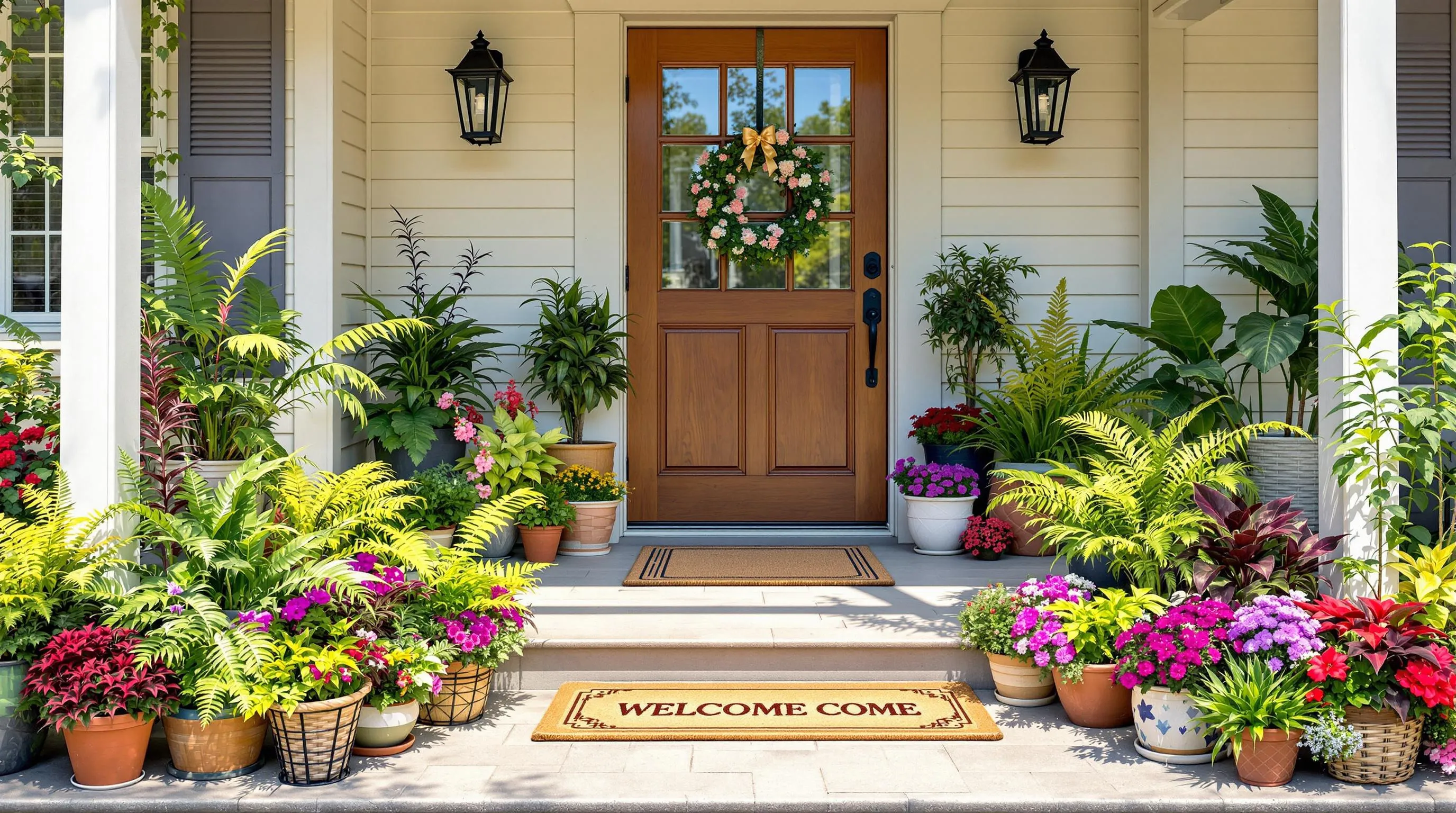
Maintaining your front porch plants requires different approaches as seasons change. A consistent care routine will ensure your entryway remains vibrant and welcoming year-round, regardless of weather fluctuations and seasonal transitions.
Watering and Feeding Schedules for Container Plants
Container plants need more frequent watering than those planted in the ground as pots dry out faster. During spring, water your potted plants 1-2 times per week, increasing to daily watering during hot summer months when temperatures exceed 85°F. In fall, reduce watering to once every 7-10 days, and in winter, water only when the soil feels completely dry, typically every 2-3 weeks. Fertilize container plants monthly during growing seasons (spring through early fall) with a balanced liquid fertilizer (10-10-10), reducing to quarterly feedings in late fall. Slow-release granular fertilizers applied every 3 months provide a steady nutrient supply for busy homeowners. Always check the moisture level by inserting your finger 1-2 inches into the soil—if it feels dry, it’s time to water.
Protecting Front Porch Plants During Extreme Weather
Extreme weather events require quick action to safeguard your porch plants. During frost warnings, move portable containers indoors or against the house wall where they’ll benefit from residual heat. Cover sensitive plants with frost cloths, burlap, or old bedsheets—never plastic—securing coverings so they don’t touch foliage. For summer heat waves, create temporary shade using umbrellas or shade cloths, and group containers together to increase humidity. During heavy rainstorms, relocate containers to protected areas to prevent waterlogging, and ensure proper drainage by elevating pots slightly off the ground using pot feet or bricks. For windy conditions, place taller plants in heavier containers or temporarily relocate them to sheltered locations. Keep vulnerable plants like ferns and tropical varieties closest to your house where they’ll receive maximum protection from elements while maintaining your porch’s aesthetic appeal.
Front Porch Plant Ideas for Different Architectural Styles
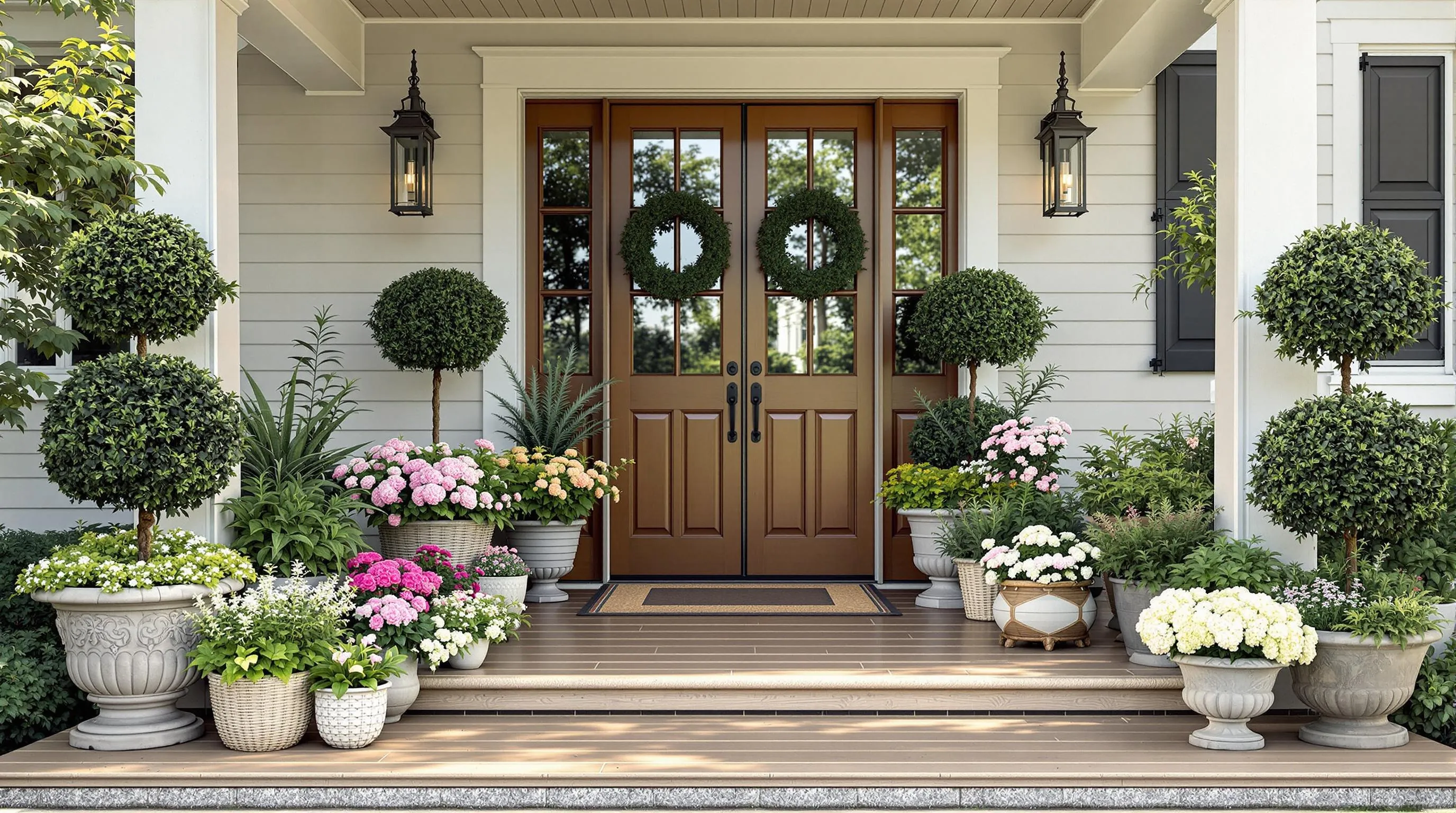
Your home’s architectural style plays a crucial role in determining which plants will complement your front porch best. The right plant selections can enhance your home’s character while creating a cohesive and inviting entryway.
Complementing Traditional Home Designs
Traditional homes like Colonial, Victorian, and Craftsman styles benefit from classic, symmetrical plant arrangements that honor their historic roots. For Colonial-style homes, consider boxwood topiaries in matching urns placed on either side of your front door for formal symmetry. Victorian homes shine with romantic, lush plantings like hydrangeas, roses, and clematis climbing ornate trellises. Craftsman porches look stunning with native plants in copper or earthenware containers—think ferns, hostas, and astilbe that highlight the home’s natural materials and craftsmanship. For Tudor-style homes, incorporate English garden favorites like lavender, rosemary, and ivy in stone or terra cotta containers to enhance their European charm. Remember to maintain clean lines and balanced arrangements to preserve the traditional aesthetic while adding welcoming greenery.
Modern and Contemporary Front Porch Plant Selections
Modern and contemporary homes call for bold, architectural plants with clean lines and dramatic silhouettes. Consider statement specimens like snake plants, agave, or fan palms in sleek, monochromatic containers for minimalist appeal. Black mondo grass, silver-blue succulents, and horsetail reed create striking vertical elements that complement modern architecture’s geometric forms. Unlike traditional homes that favor symmetry, contemporary porches often benefit from asymmetrical arrangements with varied heights and a limited color palette—think clusters of similar plants in different sizes rather than many varieties. Opt for large-scale planters in concrete, fiberglass, or metal with simple designs that won’t compete with your home’s clean lines. The key is selecting specimens with interesting forms that act as living sculptures, creating visual impact without fussy arrangements or overly complex combinations.
Creating the Perfect Front Porch Plant Display: Final Tips and Inspiration
Your front porch plants do more than just beautify your entryway—they tell your home’s story. By selecting varieties that match your architecture styling light conditions and maintenance preferences you’ll create a welcoming space that stands out in your neighborhood.
Remember to consider seasonal rotations fragrance options and natural pest-repellent qualities when planning your display. The right combination of containers and plants can transform even the smallest porch into an eye-catching garden retreat.
Start small with a few strategic containers then expand as your confidence grows. Your perfect front porch garden awaits—whether you’re drawn to lush hydrangeas architectural succulents or fragrant herbs. With these plant selections you’ll create a memorable first impression that enhances your home’s curb appeal year-round.

